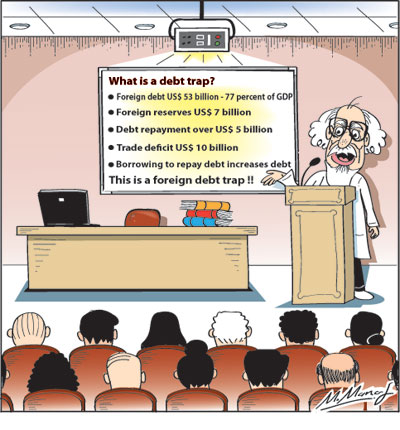Columns
Resolving the foreign debt trap and reducing external financial vulnerability
View(s):the current foreign debt of about US$ 53 billion that is about 77 percent of GDP is unsustainable. This year’s debt servicing costs of more than US$ 5 billion, together with the high debt servicing costs in the next few years, is a massive burden.
 Since we are unable to service the debt with foreign earnings, we are continuing to borrow to repay debt. Consequently our foreign debt and external financial vulnerability is increasing. Getting out of this foreign debt trap is imperative.
Since we are unable to service the debt with foreign earnings, we are continuing to borrow to repay debt. Consequently our foreign debt and external financial vulnerability is increasing. Getting out of this foreign debt trap is imperative.
The problem
There has been an escalation of foreign debt since 2008. It has shot up from US$ 11.3 billion in 2008 to US$ 47 billion at the end of 2017. It is estimated that foreign debt increased further to about US$ 53 billion at the end of 2018. This is about 77 percent of GDP.
The debt service obligations this year are estimated at about US$ 5.1 billion. This is a serious strain on the external reserves that were only around US$ 7 billion at the end of last year. To replenish the low reserves, the government has obtained several facilities from friendly countries and is issuing International Sovereign Bonds (ISBs).
Meeting debt repayment obligations by resorting to further borrowing is increasing the foreign debt and the external financial vulnerability of the country. A way must be found to reduce the large foreign debt.
 Roots of the problem
Roots of the problem
The foreign debt has increased considerably in the last decade owing to expenditure on large infrastructure development projects, loan repayments and the financing of large trade deficits, as export earnings are less than import expenditure.
High cost infrastructure
The huge expenditure on infrastructure projects has been an important reason for increased indebtedness. The cost of these projects are large and their returns are indirect and over a long period of time. They do not increase export earnings.
Some of the infrastructure projects are white elephants that have incurred further expenditure rather than yielded benefits. In many instances the costs have been higher than necessary owing to corruption, the lack of international bidding and higher costs foreign contracts that are mandatory on foreign funded projects.
Trade deficits
The country has had persistent and increasing trade deficits. The trade deficit increased from US$ 8 billion in 2015 to US$ 8.9 billion in 2016 and to US$ 9.6 billion in 2017. The trade deficit is likely to exceed US$ 10 billion in 2018 as it had reached US$ 9.6 billion by November last year.
The increasing trade deficits in 2017 and 2018 have been despite significant increases in exports. Export gains have been frittered away by increased imports, especially of fuel, vehicles and gold. The reduction of non-essential imports is essential to reduce this large trade deficit.
Balance of payments
It has not been possible to generate balance of payments surpluses to meet debt obligations owing to the large trade deficits. Consequently the country has been borrowing further to repay debt and increasing the debt and external financial vulnerability.
Reducing the debt
How do we get out of the debt trap? The simple answer is that we must earn more. We must reduce the trade deficit so that income from services generates a surplus. In recent years large trade deficits have been offset by income of workers’ remittances and earnings from tourism and other services.
However, as trade deficits have been increasing, the balance of payments (BOP) surpluses have been too little, if any, to enhance the reserves.
How do we improve our balance of payments to generate an adequate surplus to reduce foreign debt? Should we also borrow less?
Reducing the trade deficit by both increasing exports and reducing non-essential imports is crucial. There is a prospect of increased tourist earnings and earnings from information technology.
However, these gains must not be squandered by increased imports of non-essentials items. The severity of the problem requires a national response of austerity. Political leaders must lead by example especially by cutting down public expenditure.
With a foreign debt exceeding US$ 50 billion that is over 75 percent of GDP and debt service obligations of over US$ 5 billion this year and reserves of only around US$ 7 billion the country is in a serious foreign debt trap. How do we get out of the debt trap?
Way forward
Further borrowing to repay debt will only aggravate the country’s external financial vulnerability. Getting out of this foreign debt trap and reducing external financial vulnerability is imperative. Continuing to borrow to repay debt is a serious flaw in the economy. The seriousness of the problem demands a drastic solution.
The prudent management of foreign debt to ensure sustainability of foreign debt is critical. Foreign borrowing could have either beneficial or adverse impacts on long-term economic stability and development.
Therefore, management of foreign debt servicing costs is vital for economic stabilisation and long-term economic development, especially for a trade dependent export-import economy. It is vital that Sri Lanka resolves this debt trap.
Do we have the foresight and courage to take the necessary policy measures to reduce the debt or will we continue to increase foreign indebtedness?


Leave a Reply
Post Comment